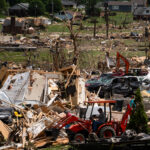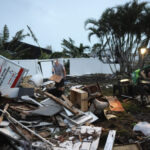A draft legislative report warns it’s likely Montana towns will burn and people will be injured or killed if the state does not change the way it deals with wildland fires.
The report was released by the Fire Suppression Interim Committee as lawmakers plan a series of meetings across the state to come up with better ways to fight fires.
Last year in Montana, more than 700,000 acres burned in 72 fires tracked by the federal government. Most were sparked by lightning.
The draft report predicted more bad fire seasons ahead due to extended drought across much of the state, rising demand for firefighting resources, and more homes built in rural areas prone to fire.
“With limited resources,” the report concludes, “it is likely that communities will burn and firefighters and members of the public will be injured or killed.”
Committee Chairman John Cobb, R-Augusta, said the dire warning was meant as a call to action.
“Where we are going now, there are going to be hundreds of homes burned up,” Cobb asked. “What can we do differently?”
Mary Sexton, director of the state Department of Natural Resources and Conservation, said agencies such as hers are trying to adapt their firefighting strategies. But so far, she said, they have not kept pace with the increasing threat.
“Because of the drought and the build up of fuels, we just are not able to be as effective as we have been in the past,” Sexton said.
On Friday, March 28, the legislative committee adopted a range of alternatives to pay for future fire fighting efforts and to address the dilemma of protecting rural homes.
For people living on the urban fringe, the committee floated a proposal for new tax incentives to encourage property owners to reduce fire risk. Other options were to give local government more power to regulate fire reduction measures — such as removing trees close to structures — and the mandatory use of fire-resistant building materials.
Proposals to change the way the state pays for wildland fires came after lawmakers in a special session last fall set up a $40 million annual fire suppression fund.
The costs of last year’s fire were even higher — $53 million. That’s more than double the $20 million average in the past decade, Sexton said.
One option offered by the committee was to set aside a portion of the state’s year-end budget balance for deposit in the fire suppression fund. Another possibility was to charge a per-acre fee to property owners living in areas considered “at-risk.”
The committee must submit a final report and recommendations to the full legislature by Sept. 15.
Was this article valuable?
Here are more articles you may enjoy.

 Trump Administration Targets Resiliency Funds to Shrink FEMA’s Role
Trump Administration Targets Resiliency Funds to Shrink FEMA’s Role  AF Group Claims Exec Embracing AI, But He Won’t Measure Success by Replacing People
AF Group Claims Exec Embracing AI, But He Won’t Measure Success by Replacing People  Here Comes Another Busy Atlantic Hurricane Season, But Will It Be as Crazy as 2024?
Here Comes Another Busy Atlantic Hurricane Season, But Will It Be as Crazy as 2024?  Brazil Sues EV Giant BYD Over ‘Slavery’ Conditions at Plant
Brazil Sues EV Giant BYD Over ‘Slavery’ Conditions at Plant 